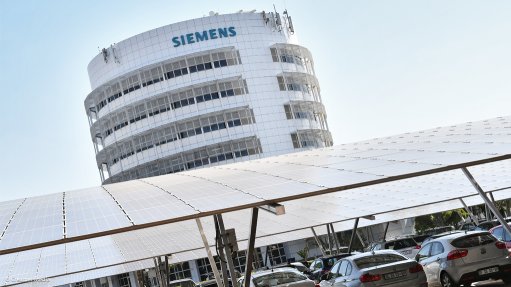
Siemens HQ and its solar car park in Midrand, Johannesburg
Photo by: Dylan Slater
German electronics manufacturer Siemens on Wednesday launched, at its headquarters in Midrand, its end-to-end distributed energy system (DES) as a solution to assist the African continent in its energy transition.
The DES provides for the targeted use of renewable energy, combined heating and power stations, as well as the provision of storage solutions.
DES technologies, Siemens CEO for Southern and Eastern Africa Sabine Dall’Omo said, represent a paradigm shift and offer building owners and energy consumers significant opportunities to reduce costs, improve reliability and secure additional revenue through on-site generation and dynamic load management.
The DES solution, she enthused, is the first of its kind in Africa and was developed in line with the company’s goal of achieving carbon neutrality by 2030 through energy efficiency, DESes and the purchasing of clean energy.
The DES results in lower energy costs and carbon emissions. By implementing the DES system at its headquarters, Siemens South Africa has reduced its energy demand from the national grid by about 40%, compared with previous years.
Further savings, Dall’Omo said, are expected with further optimisation.
The system is built around a just-below 1 MW photovoltaic solar plant, with PV panels strategically positioned throughout the Siemens campus to take “full advantage of the sun”.
The “captured” energy is then integrated into the Sicam microgrid controller.
Excess energy is stored in a 140 kWh Siestorage installation, with the entire system monitored, visualised and controlled through an Internet of Things energy platform called Monet.
The project, Dall’Omo elaborated, provides a showcase to current and prospective customers on a proven Siemens solution that will help them save energy, cut costs, lower carbon emissions and ensure uninterrupted power.
“Microgrids and DES are the ideal solution for Africa because they’re designed for a specific purpose, be it communities or industry,” she said, adding that this also means that diverse power supplies – such as solar or wind during the day – can be used, with the system to switch over to other forms of generation like biomass when the conditions for renewables are poor.
The challenges currently facing Africa’s energy sector are encouraging private businesses, communities and educational institutions to curtail their dependence on the traditional, centralised model of linear power generation and delivery, and to identify power generation solutions, Dall’Omo told those attending the launch on Wednesday.
To this end, she explained that the DES is designed to provide uninterrupted power and ensure a steady and reliable electricity supply for the continent’s growing demand. Industry, hospitals, corporate parks and small communities, for example, can improve their energy costs and operations by adopting similar strategies.
Dall’Omo said the system would eventually be connected with the Siemens Desigo building management system and smart metering network in the buildings.